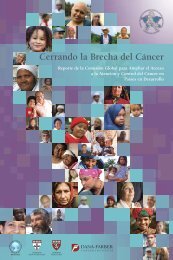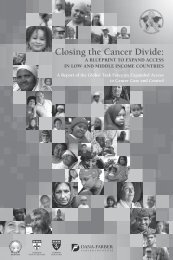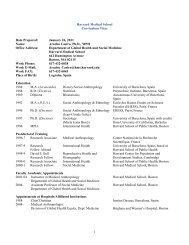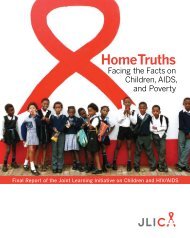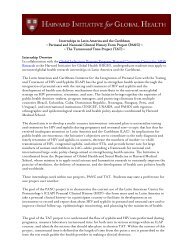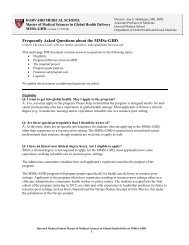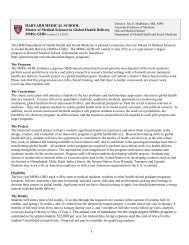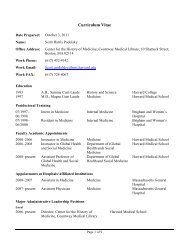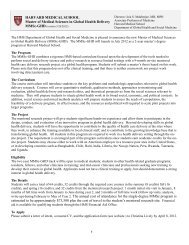Haiti Case Study - The Department of Global Health and Social ...
Haiti Case Study - The Department of Global Health and Social ...
Haiti Case Study - The Department of Global Health and Social ...
Create successful ePaper yourself
Turn your PDF publications into a flip-book with our unique Google optimized e-Paper software.
infected patients, that the surveillance system, which is supposed to monitor the situation,<br />
<strong>and</strong> provide a forecast to raise the alarm, is still dysfunctional. 169<br />
Public Information<br />
14. <strong>The</strong> population was kept informed through traditional means including broadcasting<br />
updates <strong>and</strong> cholera awareness throughout MINUSTAH FM in conjunction with other radio<br />
stations. 170 Also, recognizing the fastest way to contain the epidemic was to treat <strong>and</strong><br />
educate the limited number <strong>of</strong> patients in rural areas before the disease spread across the<br />
country, <strong>Haiti</strong>’s public health community drew up a plan to quickly fan medical teams out<br />
across the countryside. However, some participants in this study reported that the MSPP<br />
lacked the staff to implement the plan <strong>and</strong> few NGOs wanted to travel outside <strong>of</strong> Port-au-<br />
Prince where, they felt, media attention <strong>and</strong> funding was scarce. 171<br />
15. New forms <strong>of</strong> public information were also used in <strong>Haiti</strong> for the first time such as<br />
Digicel’s initiative to inform the population via Short Message Service (SMS). One<br />
interesting project tracked cell phone movements across the country. Digicel used this cell<br />
phone tracking to inform cell phone customers if they entered a cholera-contaminated area<br />
<strong>and</strong> simultaneously to provide the customer advice on how to protect themselves from<br />
cholera. Interestingly, one <strong>of</strong> the directors <strong>of</strong> the project noted, “<strong>of</strong>ten before we could send<br />
the message, the phone was on the move out <strong>of</strong> the area. Its owner was already running<br />
away from cholera.”<br />
Ensuring Access to Safe Water<br />
16. With respect to water security, <strong>Haiti</strong> appears near the bottom <strong>of</strong> the ranking <strong>of</strong> nations;<br />
indeed in 2002, <strong>Haiti</strong> ranked last out <strong>of</strong> 147 countries for water security 172 . <strong>The</strong> Joint<br />
Monitoring Programme (JMP) from the WHO <strong>and</strong> UNICEF published 173 recently that in 2010<br />
whereas almost 85% <strong>of</strong> the urban population have access to “improved” water, in the rural<br />
areas access to piped or improved water sources is still limited to 51%. <strong>The</strong> JMP also<br />
included statistics showing that in rural areas almost 50% <strong>of</strong> human waste is “open<br />
defecation” <strong>and</strong> nationwide the trend <strong>of</strong> unimproved sanitation—which means that human<br />
excreta are not separated hygienically from human contact—has worsened in the last 10<br />
years.<br />
17. Without sanitation services or even simple pit latrines, cholera easily spreads across<br />
waterways. One NGO worker told <strong>of</strong> testing the well water from a nearby deep well in the<br />
central plateau <strong>and</strong> found the number <strong>of</strong> chlor<strong>of</strong>orms to be "too numerous to count"<br />
suggesting that the water table itself has now become infected.<br />
Clean water in internally displaced persons (IDP) camps<br />
18. Fear prompted migration away from cholera-affected villages <strong>and</strong> towns into the<br />
already crowded capital city where purified water was being provided in the short-term in the<br />
IDP camps. <strong>The</strong> outbreak had relatively few cases in the IDP camps. <strong>The</strong> mean reason for<br />
this lower incident rate compared to the rural areas is that IDP camps were mostly provided<br />
with clean <strong>and</strong> chlorinated potable water by <strong>Haiti</strong>an <strong>and</strong> international actors. To give an<br />
example, peacekeepers built a water tank in largest IDP site in the country. 174 Latrines were<br />
also serviced in camps. 175<br />
Clean water in the population<br />
19. Lack <strong>of</strong> municipal water supplies <strong>and</strong> sewage treatment centres in <strong>Haiti</strong> make "point <strong>of</strong><br />
source" water purification one <strong>of</strong> the only ways to provide the population with clean water.<br />
Many humanitarian organizations provide potable water to the population, MINUSTAH<br />
contributed to this effort by distributing nearly 15 million gallons <strong>of</strong> drinking water <strong>and</strong> 16,000<br />
purification tablets <strong>and</strong> MINUSTAH’s Community Violence Reduction section has distributed<br />
more than 6000 water filtration units. <strong>The</strong> coordinated distribution <strong>of</strong> water purification kits<br />
was a big challenge.<br />
C-3



